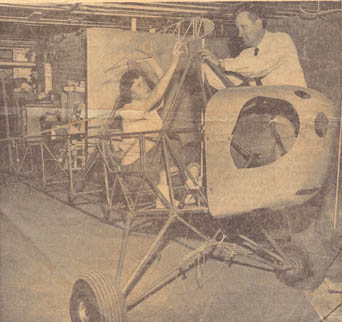
Home | Location | Contact | Donate | Ace Aircraft, Inc.
1960s - Ace Aircraft Enters the Modern Age
1960 - Corben designs a new airplane--the Corfet 150.
1960 – Ms. Barbara Boone, a 19-year-old pilot and wingwalker, partners with Mr. Thurman G. Baird, an Asheville, NC attorney and General Motors representative, to build a Baby Ace. Neither has built an airplane before. The article states that construction began last summer and should be completed in four to five more months. [1]

Fall 1960 – Mr. DuCharme is elected to the Board of Directors of EAA. [2]
1961 - The assets of Ace Aircraft Manufacturing, Inc. are sold to Mr. Edwin T. Jacob of McFarland, WI. Mr. Jacob starts Ace Aircraft Manufacturing and Supply.
July 15-September 21, 1961 - A partial set of plans is created for the Junior Ace Model E. These plans are incomplete. The plans are drawn by W. Bowser and are engineered by Carl Walters. [3]
April 18, 1962 - Mr. DuCharme transfers ownership of Ace Aircraft Manufacturing, Inc. to Mr. Warren A. Knorr of Cedarburg, WI. [Transfer]
June 1962 - Started in October 1959, EAA Chapter 70 completes a Corben Baby Ace Model D as a club project. It is highlighted in an article in Sport Aviation. [4]
August 1962 - A Corben Baby Ace appears on the cover of Sport Aviation. It was built by an Army Aviation Maintenance Officer Capt. Carl Streever. He started the construction in the United States and completed the aircraft in Germany with parts from all over the world. The aircraft is termed the "United Nations Baby Ace." [5]

September 1962 - A Corben Baby Ace appears on the cover of Sport Aviation. It was built by Lloyd Feary of Webster, N.Y. [6]
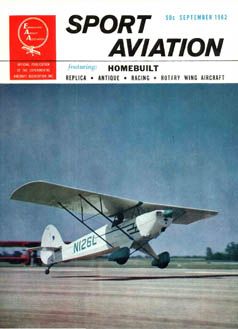
November 1962 - A Corben Baby Ace Model D seaplane appears on the cover of Sport Aviation. It was the second Baby Ace built by Casey Lambert of St. Louis, Mo. [7]
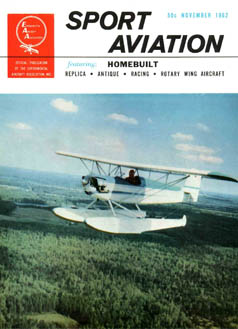
August 29, 1963 - Mr. Poberenzy responds to the July 16th letter from Mr. Walter Waktins of Victoria, Australia about the amateur-built aircraft movement in the United States and Canada and information about the Baby Ace Model D. [Letter}
1964 - The Junior Ace Model E appears for the first time in Jane's All The World's Aircraft's 1964-65 edition. [8]
January 28, 1965 - Ace Aircraft Manufacturing, Inc. [of Wisconsin] changes its name to Ace Aircraft, Inc [of Wisconsin]. [Amendment]
1965 - Mr. Jacob sells the assets of Ace Aircraft Manufacturing and Supply to Mr. Thurman Baird of Asheville, NC, who founds Ace Aircraft Manufacturing Company.
December 31, 1965 – Mr. Baird sends a letter to Mr. Corben stating he has spent the last six weeks cleaning the rust off the tooling he acquired from Mr. Jacob. Mr. Baird also states he has Corben’s original fuselage jig. [Letter]
February-May 1966 - Sport Aviation republishes Mr. Corben's 1935 Popular Aviation articles on building the Super Ace. [9]
March 24, 1966 – Mr. Carl Walters replies to the March 20th letter from Mr. Baird. Walters states he is interested in selling Baby Ace N6887D for $1,500. The aircraft was damaged in an accident, and Walters has not had the time to repair it. Walters goes on to explain that he was a partner of Mr. DuCharme and owned 10% of the controlling stock in Ace Aircraft Manufacturing in West Bend, WI. Walters ends by asked Baird if Walter’s name is still shown on the plans as engineer. [Letter]
March 25, 1966 – Mr. Corben sends a letter to Mr. Baird stating he has just acquired a Baby Ace that was built in Ohio, and he intends to install floats on the aircraft. [Letter]
March 30, 1966 – Mr. Baird sends a letter to Mr. Walters stating that the Walters’ name is still on most of the plans. Baird also writes that the Junior Ace plans are not finished and Mr. Jacob had been selling them that way. [Letter]
April 5, 1966 – Mr. Walters writes to Mr. Baird stating that he is surprised that Mr. DuCharme had left Walters’ name on the plans since they had not parted as friends. Walters comments that he had a completely welded Junior Ace fuselage which was to be the company’s experimental model. One day after work, Mr. Walters returned to the company to discover that his partner had crated and shipped the fuselage to someone in Elmsford, New York. Since it was impossible to complete the Junior Ace drawings without the fuselage, Mr. Walters just quit. He goes on to state that there were a few things that needed to be changed--primarily the wing strut fittings. [Letter]
April 17, 1966 – Mr. Walters replies to Mr. Baird’s letter of April 10, stating that he is using his Baby Ace to redesign the wings. Walters states that this Baby Ace will pay for itself with the publicity it will generate, and comments that during the last year Walters was with Ace Aircraft and Manufacturing, they sold $25,000 in parts alone. [Letter]
May 10, 1966 – Mr. Corben writes to Mr. Baird stating that Corben may sell the Swift Modifications business. Corben also writes that he has an original number one Baby Ace kit he would like to sell for $425. [Letter]
May 16, 1966 – The Mechanix Illustrated Baby Ace Model C is donated to the EAA Museum. It is registered as N9050C. [10]
May 23, 1966 – Mr. Corben writes to Mr. Baird stating that he will be selling the Swift Modifications business by the end of the month. Corben states that all his money is tied up in projects, and he doesn’t expect to get his money back. Although he has been flying his Baby Ace around the airport, he has not had time to put floats on the aircraft. [Letter]
May 31, 1966 – Mr. Baird writes to Mr. Walters proposing several financial trades for Walters’ Baby Ace. [Letter]
June 5, 1966 – Mr. Walters writes to Mr. Baird responding to Baird’s financial propositions for Walter’s Baby Ace. [Letter]
June 11, 1966 - Mr. Baird writes to Air Progress magazine asking if they would be interested in doing an article on building the Junior Ace Model E. [Letter]
June 12, 1966 - Mr. Baird writes to Mechanix Illustrated magazine asking if they would be interested in doing an article on building the Junior Ace Model E. [Letter]
July 29, 1966 – Mr. Corben writes to Mr. Baird stating he had finally sold the Swift Modification business. He states that he has started to installed molded floats on the Baby Ace. Corben then asks Baird if he knows of any young man that wants to learn the business of aircraft designing and building. Corben claims he cannot pay a large salary but can give them far better training than they would receive in any school. In a hand written post script, Corben states that he intends to build up the original Baby Ace kit he previously offered for sale. [Letter]
August 13, 1966 – Mr. Baird writes to Mr. Corben stating he went to Tomahawk, Wisconsin to pick up the remains of the original Baby Ace Model D. Baird claims to have everything except the wings because the wings were damaged in a ground loop a couple of years ago. Baird then states that the plans for the Junior Ace Model E were incomplete and asks if Corben can finish the drawings. [Letter]
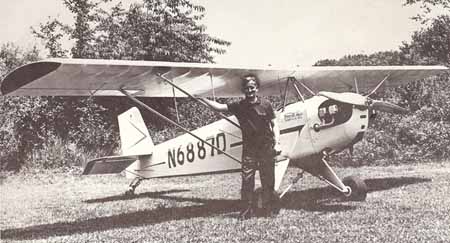
August 18, 1966 – Mr. Corben writes to Mr. Baird stating that the original Junior Ace did not use the Baby Ace wings. Corben comments that he does not know what his plans are for the future, and he will be pleased to make the drawings for the Junior Ace. Corben concludes by saying he has not had time to work on building his original Baby Ace. [Letter]
August 28, 1966 – Mr. Walters writes to Mr. Baird stating he hopes that Baird made it back to North Carolina successfully with the original Baby Ace Model D. Mr. Walters includes a Bill of Sale for the Baby Ace with this letter which states that the fuselage was factory built in West Bend, Wisconsin and is serial number #101. The selling price was $500. [Letter] [Bill of Sale]
November 1, 1966 – Mr. Corben writes to Mr. Baird stating that he may have a draftsman that can help if Baird wants to draft a new set of Junior Ace plans. Corben tells Baird that he thinks homebuilders are starting to want fasters aircraft with a more high performance look, and Corben tells Baird he has some new ideas if Baird is interested. [Letter][Corfet Form Letter]
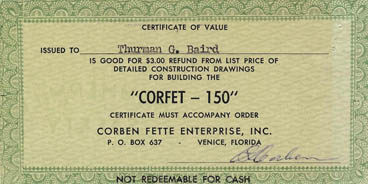
April 1, 1967 - The Federal Aviation Agency becomes the Federal Aviation Administration under the newly created Department of Transportation.
May 1, 1967 – Mr. Dzik writes to Mr. Baird stating he is will bring the Junior Ace plans up-to-date for an initial payment of $450 plus $11.50 for each set of plans sold until the remaining balance of $950 is paid. Mr. Dzik believes he can have the plans completed by October. [Letter]
December 20, 1967 – Mr. Corben writes to Mr. Baird stating he has had to sell both of his Baby Aces for financial reasons. Once again, Corben tells Baird of his new wooden aircraft design—-a redesign based on the Swift. [Letter]
March 23-May 12, 1968 - Mr. Baird has the Junior Ace Model E plans finally completed. The 10 remaining sheets are drawn by A. D. Harmon. [3]
May 30, 1968 - Mr. Corben dies in Sarasota, FL at the age of 64. According to his funeral announcement, Corben was only 63. [11]

April 29, 1969 - After several years of certification effort, the Baby Ace Model D is granted Amateur Built Aircraft Approval No. 12 from the Commonwealth of Australia's Department of Civil Aviation. [12]
1 Freeman, Earl. “Barbara Boone, Pilot-Wingwalker, Building Airplane,” Asheville Citizen-Times, Section D, June 5, 1960
2 Zeisloft, H. "Meet the Competition Judges," Experimenter, January 1961, p. 38
3 Junior Ace Model E Plans
4 Miller, B. "Our First EAA Chapter Project," Sport Aviation, June 1962, pp. 16-18
5 Sport Aviation, August 1962, Front Cover
6 Sport Aviation, September 1962, Front Cover
7 Kohm, L. "Lambert's Favorite Airplane," Sport Aviation, November 1962, Front Cover and pp. 4-7
8 Jane's All The World's Aircraft, 1964-65, p. 168
9 Sport Aviation, February – May 1966
10 “The Baby Ace Comes Home,” Sport Aviation, July 1966, p. 12
11
http://www.aviationhalloffamewisconsin.com/inductees/corben.htm
12 Amateur Built Aircraft Approval No. 12, Commonwealth of Australia, Department of Civil Aviation, April 29, 1969

MUSEUM
Page last updated: Thursday, November 8, 2012